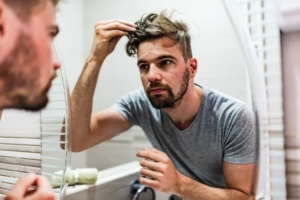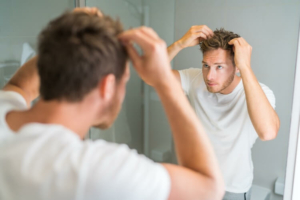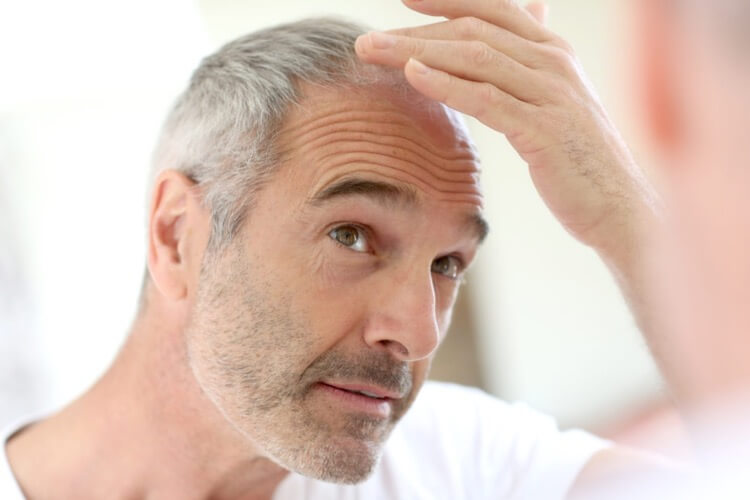Is Your Hair Healthy?

Has your hair been a little drier and frizzier than usual? Is it less manageable than it used to be? Figuring out whether or not your hair is healthy can be challenging. It can be difficult to distinguish between when it’s time for a deep conditioning treatment and a haircut or if something else is affecting your hair. If you know what to look for, though, assessing your hair’s health is easy. Here’s a simple guide designed to help.
How Do You Know When Your Hair is Healthy?
Is your hair smooth and shiny or dull and coarse? Hair that’s shiny and smooth is deemed more healthy, even when hair is wavy or curly. (01) As we age, natural graying can make hair seem dull or frizzy, but that doesn’t have to be the case. Daily conditioners, moisturizing treatments, and shine-boosting sprays can help.
Androgenetic alopecia, a fancy name for male and female pattern baldness, can also change your hair’s texture and appearance. Sometimes hair becomes finer due to miniaturization of the hair follicles. Because the hair becomes thinner, it could become curlier. In other cases, previously curly or wavy hair can flatten and be less able to hold its curls or waves.
Healthy Hair From the Inside Out
Healthy hair isn’t just what you see on the outside. What’s on the inside also counts. Hair is primarily made of keratin, which is a protein. Keratin is made out of amino acids and other molecules that come from foods we eat. That’s why eating a balanced diet and ensuring that you have all the right vitamins are so essential.
Your hair grows from a follicle beneath your scalp’s skin. A hair shaft extends from the follicle. The shape and angle of your hair shaft are what determines what type of hair you have. It’s made out of three layers:
- Medullar- Inside layer
- Cortex – Middle layer that determines your hair color and elasticity
- Cuticle – Outside layer that makes your hair look shiny
When the cuticle is damaged by the sun, chemicals, blow drying, or other elements, the cells in the cortex can break or unravel, making your hair look dull or brittle.
What Damages Healthy Hair?
Typically, the hair’s cortex is filled with keratin, and the cuticle is smooth, allowing light to reflect. When the cuticle is damaged, your hair may seem dry and frizzy. The ends may be thinner than they used to be, but there is still an opportunity for repair. A haircut, deep conditioning, and time to regrow usually solve the problem. When the cortex is damaged, salvaging the hair is more complicated. At that point, hair is coarse and dull with split ends and some breakage.
Does Healthy Hair Fall Out?
According to the American Academy of Dermatologists, losing about 50 to 100 hairs per day is normal as part of the hair’s growth cycle. (02) So, even if your hair is healthy, you might still see a few strands in the sink. When you lose more than that, there’s a problem. Hair loss due to physical defects is unusual compared to other types of alopecia. Here are four of the most common ones:
- Loose anagen syndrome – When hair is loose and easily pulls out of the follicle because the root sheaths are not fully formed. More common in children than adults.
- Traction alopecia – When hair is pulled out of the follicle by tight hair bands, braids, or any other styling habits.
- Trichotillomania – A type of obsessive-compulsive behavior when people pull out their own hair.
- Overprocessing – Straighteners, perms, bleach, and dyes use harsh chemicals that can break down your hair’s fiber. Using these harsh chemicals too often or incorrectly can irreversibly damage the hair’s fiber.
Other Reasons for Hair Loss
If you are losing your hair, and it’s not due to a physical defect, it may be due to alopecia. Here are some examples:
- Telogen effluvium is a temporary form of hair loss that can happen after sudden illness such as Covid, surgery, or a stressful occasion. Hair spontaneously regrows after a few months.
- Androgenetic alopecia (male or female pattern baldness) is the most common form of alopecia. Although it commonly occurs during middle age, people in their 20s may have this type of hair loss due to an overproduction of Dihydrotestosterone (DHT). Minoxidil, Finasteride, Dutasteride, and Spironolactone are prescription DHT blockers often prescribed to reverse hair loss caused by male and female pattern baldness.
- Alopecia Areata is an autoimmune condition that causes circular bald patches about the size of a quarter. In addition to Minoxidil and Finasteride, immunosuppressants have recently been found effective in helping people with alopecia areata regrow their hair.
How to Keep Your Hair Healthy
Want your hair to look shiny and healthy? Here are some tips to help you keep your hair in top condition:
- Diet – Eat a well-balanced diet with plenty of vegetables, fruit, and plenty of protein
- Vitamins – Check your vitamin levels, especially biotin, iron, vitamin C, niacin, and zinc. Work with your dermatologist to supplement if any levels are low
- Exercise – Regular exercise not only helps manage your weight and keep your heart healthy, but it also reduces stress which has been proven to affect your hair
- Habits – Quit smoking and only drink in moderation
- Sun protection – Wear a hat when you’re in the sun to prevent damage from ultraviolet rays
- Chlorine – Wear a swim cap when swimming, or rinse your hair before or after swimming to get all of the harsh chlorine out
- Wet Hair – Use a wide-tooth comb and treat wet hair gently
- Condition – Use a quality conditioner each time you wash your hair
- Styling – Watch heat styling, eliminate or minimize chemical treatment, and avoid tight hairstyles (ponytails, braids, buns, etc.)
No matter your age or gender, having healthy hair is a confidence booster. If you have questions about your hair’s health or are concerned about hair loss, let us know. One of our board-certified dermatologists will review the information you provide and let you know if you would benefit by using one of our customized prescription medications.
Resources:
(01) https://pubmed.ncbi.nlm.nih.gov/18004288/
(02) https://www.aad.org/public/diseases/hair-loss/insider/shedding#:~:text=It%27s%20normal%20to%20shed%20between,this%20condition%20is%20telogen%20effluvium.






